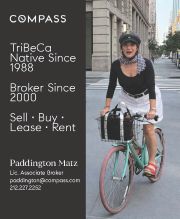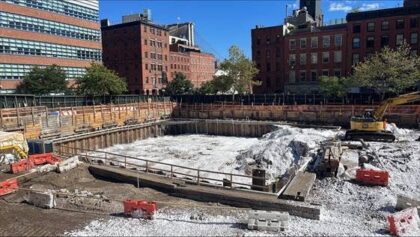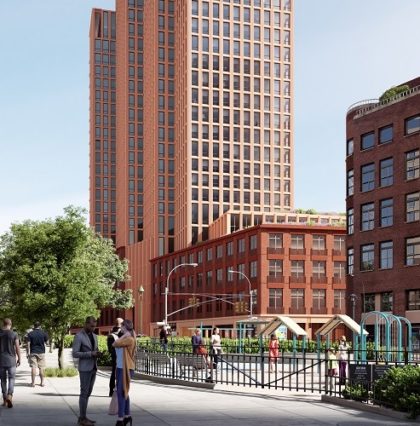Categories
Left column house ads
Lawsuit stops development of Seaport tower
October 12, 2022 Community News, Restaurant/Bar News
The Seaport Coalition, the group of neighborhood organizations (Save Our Seaport, Children First NYC and Southbridge Towers) that has been defending the lot that is 250 Water for decades, successfully stopped progress on the site in court this week.
New York State Supreme Court issued an order that prevents the Howard Hughes Corporation from “taking any action in furtherance of construction of the 250 Water Street Building” this year “pending a hearing and a decision by the Court on the merits” of a lawsuit against HHC and the NYC Landmarks Commission.
The group filed the suit against the developer and the city to preserve the low-rise nature of the South Street Seaport Historic District. The building — you can read more about it here — will rise up to 324 feet, or 26 stories. They argued that the Landmarks Commission should not have considered support of the South Street Seaport Museum (which stands to get $50 million from the developer when the project moves forward) when considering the rezoning.
From Judge Arthur F. Engoron: “LPC considered approvals of the Tower and work on the South Street Seaport Museum in tandem, allegedly to provide “political cover” for the Tower. This Court is all in favor of funding for museums, but not as a quid pro quo for approval of a massive skyscraper in an historic district that otherwise would be prohibited.”
From Howard Hughes: “We firmly disagree with this ruling. Regardless of this decision, we remain confident that this lawsuit is meritless, and the courts will agree that the Landmarks Preservation Commission’s approval of our project was proper and made in full accordance with the Landmarks Law. Supporters around the neighborhood and across the city agree with transforming the parking lot at 250 Water Street into an architecturally distinguished building that is appropriate to the Historic District.”
12 Comments
Comment:
Subscribe
Subscribe to the TC Newsletter

















Landmarks and real estate developers are holding hands and scratching backs. Landmarks’ protection of historic district is sad, and way too vulnerable to political pressure.
I dont have sympathy here for the plaintiffs. Its NYC and lower manhattan. Unless there was a counter proposal showing something really valuable or historic in nature, this project should go forward. There are tall buildings all around. If more public funds are needed, great, settle and move on
Patrick -you are not understanding the situation. So what if there are tall buildings all around? Is another one really necessary right in this spot? In 2003 the height limit was created after multiple proposals were rejected (one was approved and not built) .It should be honored. This historic district preserves the tiny remaining remnant of the maritime past of New York City, with the scale of the 18th and 19th century buildings creating a sense for visitors of what New York was. The proposed building has nothing at all to connect it to the history of the district.
Yes, it absolutely does. People like you are why housing prices are outright unaffordable in both Lower Manhattan and the greater NYC area. Go live in the country if you don’t like having construction projects around you.
You are in NYC….Tall builidings everywhere…hello…move to ohio…
Using city housing prices as the reason for building a high-rise within a historic district seems a bit absurd. The percentage of vacant real-estate in the city is much higher than pre pandemic, yet condo rents reached an all time high. Building a new generic looking high-rise right next to the Brooklyn Bridge solves nothing for nyc housing.
Btw, no other countries are building new high-rise condos right next to their historic landmarks. New York is unique, but never without taste.
Just to clarify: “…which stands to get $50 million from the developer when the project moves forward”.
From the start, the Howard Hughes Corp. deceptively promoted $50 million (subsequently reduced to $40MM) as if it were an out-of-pocket contribution / gift from them, rather than what it actually was revealed to be – money required for HHC to purchase “air rights” from the City that it needed to build a 324ft tower in the Historic Seaport. HHC getting credit for a misleading representation of NYC taxpayer monies is ridiculous at best.
NIMBYism at its worst.
The site in question is an underutilized parking lot that requires remediation in order to develop. The developer’s plans for this site are not only appropriate, given surrounding context, from a massing/density perspective, but also pay architectural homage to the surrounding historic district.
This is the type of “don’t block my water view” NIMBYism from neighbors masquerading as a social justice concern. Ironically, net result of no or a slowdown in construction will be higher building costs and less overall housing supply in the near term, in each case passed along in increased prices/rents to New Yorkers.
If all of the New York local residents (who lives within the historic district or in surrounding buildings) think the developers plan is inappropriate, it would be really arrogant for the developer to come in and tell the locals: I think my building pays architectural homage to your area.
What you’re describing is textbook NIMBYism. I, too, can define a self-serving subset of any population to achieve the stated outcome I prefer (“five people that live at my address agree that’s Joe’s Pizza is the best in the city”).
The developer’s plans are appropriate given height/massing on the same block (indeed, the developer thoughtfully steps up height as the building moves from the historic core to the periphery, where tall buildings abound), add lots more housing stock to an in-demand area, and are architecturally well conceived.
Whatever your views, this development is going to happen; only thing these actions achieve at this point is to increase costs for future buyers/renters and delay taxes payable to city coffers.
The situation is not as black and white as you portray it. Clearly this lot should be used for something other than parking cars. But it should also not be used for 200-foot plus residential towers. Howard Hughes needs to quit its anchoring bias and realize that it overpaid when it bought the lot for $180 million. Take the write-down and develop something no higher than the surrounding buildings. It still might be economic to do so, just based on projected return on construction costs. Something like Dekalb Market in downtown Brooklyn would work out fine.
And we actually don’t need affordable housing subsidized by the taxpayers. If you want affordable housing, don’t live in Manhattan! You think we need another blot on NYC like South Bridge and the projects on the other side of the Brooklyn Bridge? That stuff should be razed and replaced with something better.
From your comment, it seems the developer you described here is knowingly trying to build above a height restriction at a historic district area, but calls it “textbook NIMBYism” when residents who lived here for decades requested a simple height correction.
I think the following statement is also overtly aggressive from a multi billion dollar developer to local residents as well: “Whatever your views, this development is going to happen…”